Guide to Caring for Orchids
The reasons to welcome an orchid into your home are numerous; for a start, they’re beautiful, straightforward to care for, and they bloom for months on end. They come in various vibrant colours too, as well as serene whites, pinks and creams. It’s no wonder that they’re a go-to houseplant choice.
Orchids have always been a household favourite; with over 25,000 varieties to choose from, it also makes them one of the largest flowering species of the plant world. Something else many people may not be aware of is that vanilla pods derive from an orchid called Vanilla planifolia.
Phalaenopsis orchids are epiphytes, air plants, and also lithophytes which grow on other plants for support without harming them. Typically, the wild orchids can be found growing in trees, clinging to the bark, or occasionally in rocky crags. Their thick green roots are exposed to the air and designed to absorb water and nutrients from the rain, fog, and decaying matter.
Cymbidium is one of the oldest cultivated orchids, with records dating back to ancient China BC. Cymbidiums will also grow in trees or rocks, but they are also capable of being more terrestrial, where they can also thrive in the ground with the right conditions. They are one of the hardiest orchids and capable of reaching lower temperatures than most; in fact, the change in temperature from morning to night through the change of seasons is one of the key factors to bring the plant back into flower for the following year. Cymbidiums have pseudobulbs at the base of the leaves where they can store nutrients and water.
Each orchid has specific needs in care and conditions they require and how to get them to reflower. Below we will cover Moth and Wild Orchids, which are both from the Phalaenopsis family, and Cymbidium, the King of Orchids.
How to care for Phalaenopsis Orchids – Moth Orchids and Wild Orchids
The care and conditions for Moth and Wild Orchids are identical; Wild Orchids were used to cultivate Moth Orchids until eventually they succeeded in growing the Moth Orchid with larger flowers than the wild counterparts and in many different colour variations that we know and love today. The only colour flower that does not exist in the Phalaenopsis world is blue. Blue orchids found in the supermarkets are fed with dyed water. We have always preferred all plants as nature intended, so we have never sold painted or dyed plants on our website.
The Phalaenopsis orchid does best in bright but indirect light for most of the year, but it can do well in darker spots in the home if you are limited, To help bring on the blooms, typically you would move your orchid to a cooler, darker spot in your home for a couple of months a year or for as long as it takes to start forming a new flower spike. If you have not had any flowers for a while, try moving it near a north-facing windowsill for a couple of months, or just changing the environment. They are best kept in a slightly humid environment that has a stable temperature of 15 degrees Celsius and above, for the longest lasting blooms.
Typically you should repot your orchid every couple of years, but the main difference here is not potting into a larger pot, it is more about removing damaged and rotting roots and putting in fresh, chunky bark compost to improve airflow around the root ball.
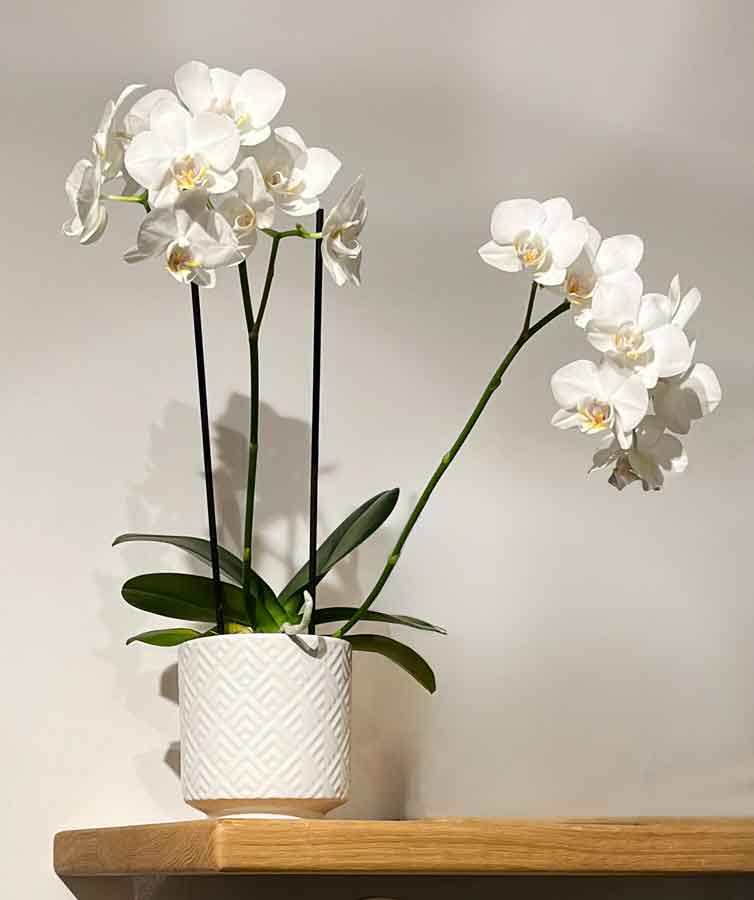
Watering in a traditional clear plastic pot with drainage holes
When Phalaenopsis Orchids start to get thirsty, the roots turn to a silvery green, so the best way we have found to water orchids is to completely drench the root system as soon as the roots turn silver. If your orchid is in a plastic see through planting pot with drainage holes, put the plant in the sink and put lots of water through the pot, then leave it to drain. Typically after a good water, the roots will turn back from silver to a lush lime green colour. You can even plunge them in room temperature water for a few minutes and then take them out and leave the excess water to drain away if that is easier for you.
Always avoid getting water in the crown of the plant where the leaves grow from, as this can cause rot. If you do get water in the crown, tip it out.
It is best to avoid watering on a routine, as orchids have another way to let us know when they are ready for a drink; they will drink more in summer and less through winter, so if you look at the colouring of the roots instead, you cannot go wrong. It is best to avoid putting ice cubes in the pot to water as this can send your orchid into shock - these tropical plants hate the cold and putting a freezing water cube will be sure to upset it.
Watering in an enclosed container without drainage holes
We also sell these orchids in glass terrariums and glass pots, which are sealed containers without drainage holes. The best way to water these is by pouring in room temperature water, almost up to the top, let it sit for a few minutes, then pour away the excess water. Be sure to support the bark and moss firmly in place as best you can when pouring out the excess water. The following day you may see a puddle of water in the bottom again, so drain this off again after the water settles. Orchids that are in contained environments need less water putting through the soil. You will only need to do this occasionally as the glass helps to keep the orchids in high humidity conditions.
The other thing with the glass containers is light; some of the roots will have a bit of light shining through. Orchid roots also photosynthesis a little which is what keeps them green. If they have a long period in the pot with no light, you will notice the roots will become yellow, but as long as they are not rotting or soft they are fine.
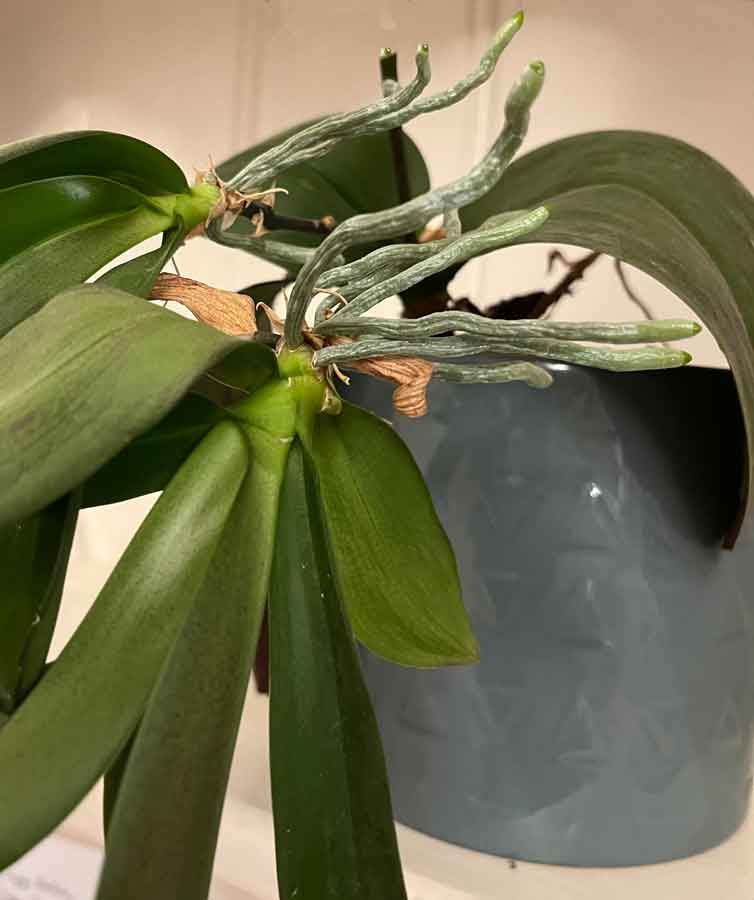
Feeding Phalaenopsis Orchids and how to get them to reflower
Phalaenopsis Orchids are not greedy plants and only need minimal fertilisation to really thrive, so you just need to give them a low dose of specialised orchid fertiliser once every other or third time you water.
You can expect Phalaenopsis Orchids to flower again when they notice the temperature drop, usually in autumn, and then they will start to bloom from winter through to spring. You can also try to bring on flowers by moving the plant to a colder spot in the home, a spot that perhaps gets a little less natural light at any time of the year for 2-3 weeks and then move it back to its usual warm spot. Letting them get down to about 10 degrees Celsius at night if possible, as it is the change in day and nighttime temperatures that spur on the next lot of blooms.
After the flowers have finished, you can either cut the spike right back to the ground where it had grown from or cut down the spike and leave two nodes - the little joints with a tiny triangle sheathe. This way if the plant is strong, it will be able to branch out from the same spike and flower again. You can also leave it as it is, cutting off only the brown and clearly dead parts of it - this will usually result in very long and mostly unsightly spikes, but often it will also result in the plant growing baby orchids also known as ‘keikis’.
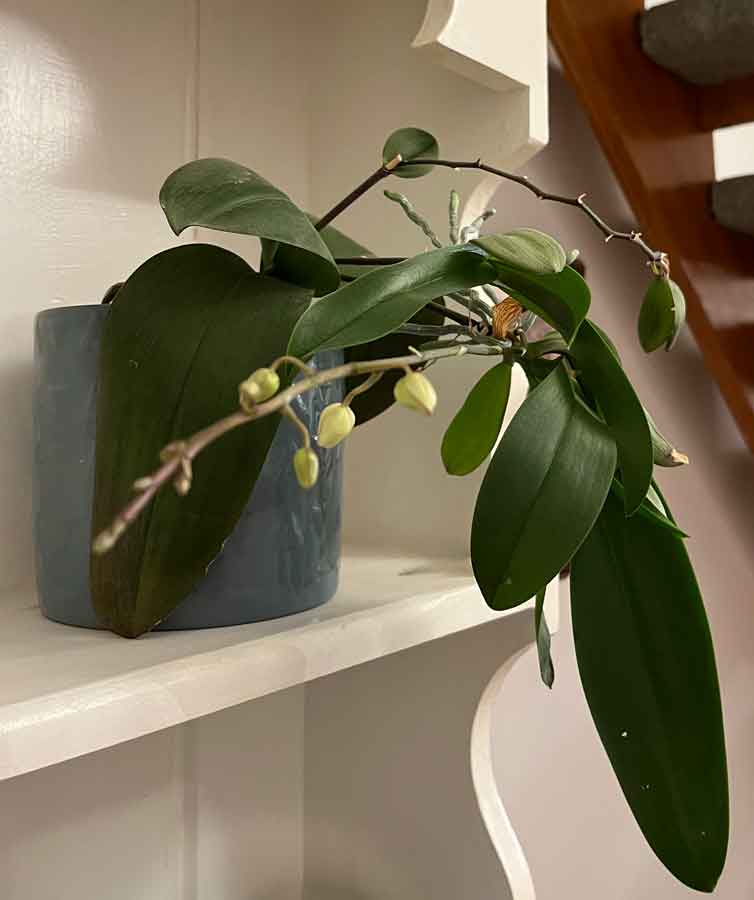
Potting on your Phalaenopsis Orchid and Root Care
You don’t need to go into a larger pot when potting on orchids; most of the time they will be perfectly happy and able to go back into the same size pot. However, it is important to take the orchid out of the pot and give the roots a good wash down. Be sure to cut away any decaying and soft roots, then use a fresh new orchid compost that has nice chunky bits of bark, to improve the air flow around the roots.
How to Care for Cymbidium Orchids
Cymbidium is one of the oldest cultivated orchids, with records dating back to ancient China. Cymbidiums will also grow in trees or rocks, but they are also capable of being more terrestrial, where they can also thrive in the ground with the right conditions. They are one of the hardiest orchids, and capable of reaching lower temperatures than most. In fact, the change in temperature from morning to night through the change of seasons is one of the key factors to bring the plant back into flower for the following year. Cymbidiums have pseudobulbs at the base of the leaves where they can store nutrients and water.
Cymbidiums, known as the King of Orchids, are easy-care orchids that make a real statement in any home. They can tolerate more direct light and cooler temperatures and household heating better than Phalaenopsis Orchids, so in summer are happy out in the garden in a semi shaded spot that gets some shade through the hottest part of the day.

How to Water Cymbidium Orchids
Cymbidium watering needs vary from season to season. Through the growing period from mid spring through summer, they will need the soil to be always kept slightly damp - they drink much more when they are actively growing new foliage. Through the colder months, you need to let the planting medium dry right out between waterings, so water few and far between through the winter months.
Feeding Cymbidium Orchids and how to get them to reflower
The most common question we get asked about Cymbidium Orchids is how to get them to flower again. Most people keep the plant in a stable temperature indoors, never move the plant from its normal position, and find the plant never flowers again.
The main thing that helps these plants to flower is the drop in temperature from daytime to night time. Cymbidium orchids need to feel the change between these temperatures and the change of seasons to help to bring on flowers. This is your perfect excuse to give this type of orchid a holiday in the garden through summer till autumn. Cymbidiums are one of the very few orchids that can tolerate being outside in the UK for a while.
We have also found by keeping the plants in the pot for a while, so they get quite pot bound, seems to impact how many buds blooms the plant grows. Putting a little bit of stress on the plant does seem to have an impact. A couple of years ago we had a left-over Cymbidium passed its flowering period; we never potted it on, watered it only when it dried out, and occasionally gave it a bit of our usual citrus winter fertiliser from time to time. Otherwise it was fairly neglected. It was kept in a very bright spot in our glasshouses too. Earlier this year we were stunned to find that it had grown at least 8 flower spikes, and after a few months rest after the last batch of spikes died back, it is growing another batch of flower spikes. It is worth noting that our glasshouses do have big difference in day and night time temperatures.
Unlike Phalaenopsis the Cymbidium will need to be either split at the base from time to time, creating more room to grow on by splitting the plant in half, or potted on or potted into a larger container every few years. The soil will need to be fast draining mix, but a 50/50 mix of Orchid bark compost for orchids and regular house plant compost will work well.
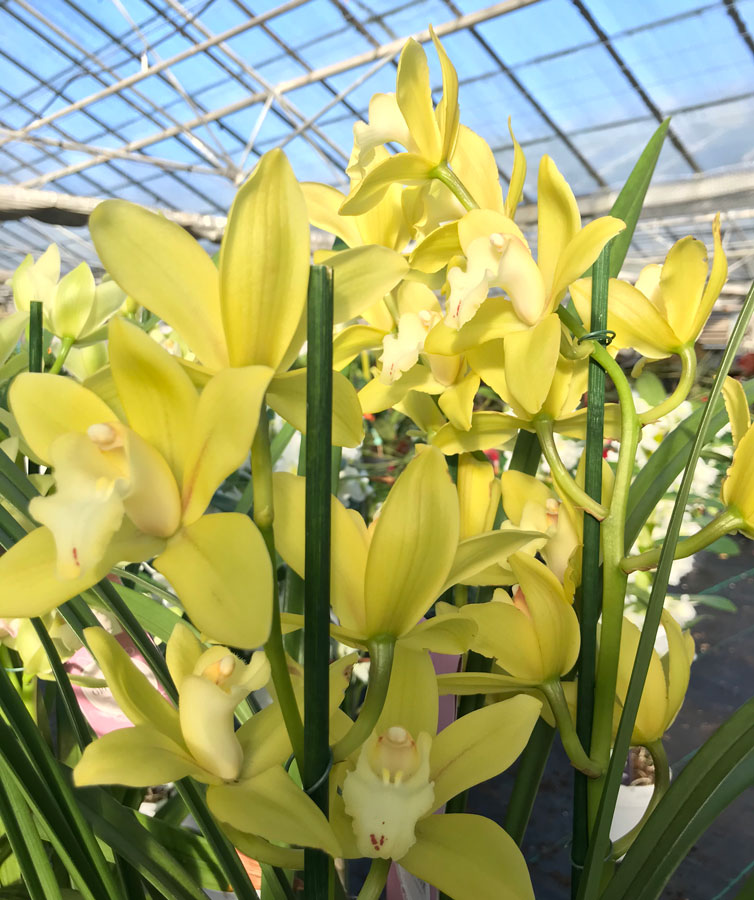
Buy Orchids Online
At Plants4Presents, we pride ourselves on selling only the best, premium-grade British twin-stemmed Moth Orchids and statement Cymbidium Orchids that you can enjoy at home or give to a loved one. Orchids make fantastic gifts, brightening up windowsills for months at a time, and by selecting one from Plants4Presents, you can be confident that it will be a superb specimen, arriving on your doorstep looking absolutely fabulous.
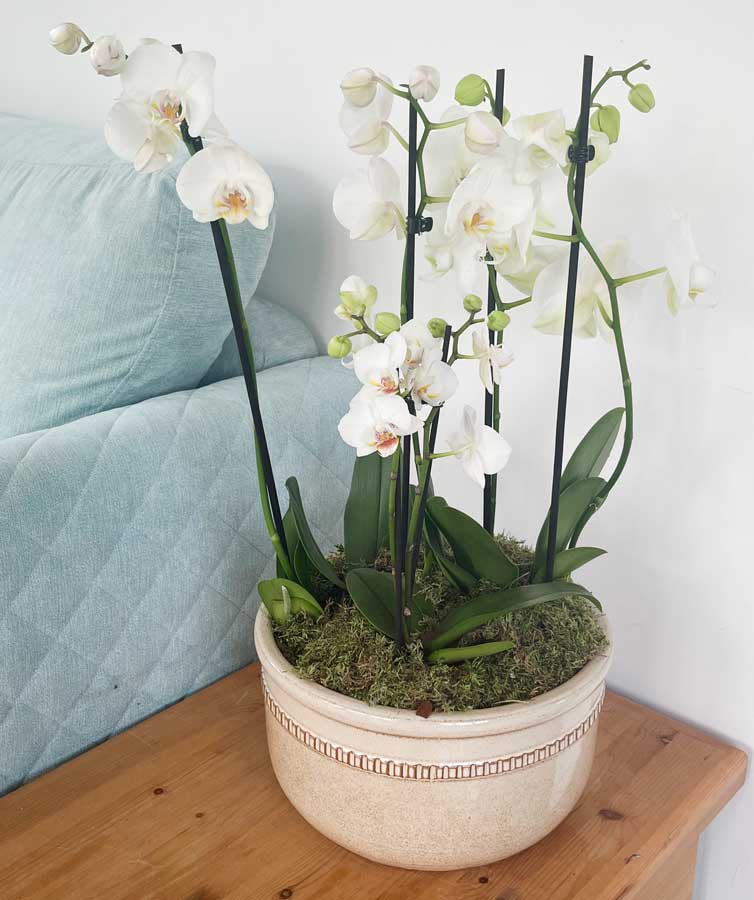
Orchid Care Frequently Asked Questions
What should I do if my orchids have white spots on the leaves?
White spots in the middle of a moth orchid’s leaves are usually scorch marks caused by too bright a position. Too much bright, direct sunlight on the leaves, or water left on the leaves when the plant is in the sun, can cause these markings, in which case you should move the orchid to a less sunny position. We’d also recommend being careful when you are watering not to leave any moisture on the leaves.
My orchid’s buds aren’t opening, or are dying before they become flowers - what’s wrong with it?
This is generally an indication that your plant isn’t as warm as it would like to be - cold air can damage the delicate orchid buds. Ensure it’s positioned in a warm room, ideally one that stays consistently above 18°C.
Why are there black spots or mould on my orchid’s flowers?
This usually occurs in very damp conditions without proper airflow, such as Victorian green houses. If you spot that this is happening, move your plant into a room with better airflow.
Why is my orchid struggling to flower?
Your moth orchid could do with a change of scenery if it’s not flowering again as expected - try a new position for it.
Why are my orchid’s leaves soft, brown or mouldy?
This is generally due to overwatering, or a cold environment. Remove the damaged leaves and try moving to a drier, warmer position, and adopting a watering schedule that sees you water with only a small amount and only when the roots turn from green to silver.

